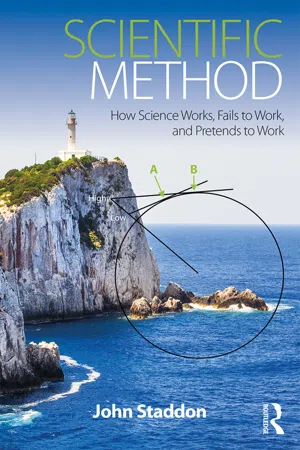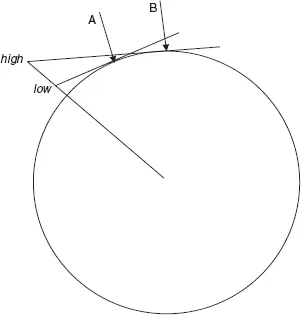![]()
1
BASIC SCIENCE
There are and can be only two ways of searching into and discovering truth. One flies from the senses and particulars to the most general axioms, and from these principles, the truth of which it takes for settled and immovable, proceeds to judgment and to the discovery of middle axioms. And this way is now in fashion. The other derives axioms from the senses and particulars, rising by a gradual and unbroken ascent, so that it arrives at the most general axioms at last. This is the true way, but as yet untried.
Francis Bacon, comparing deduction and
induction as routes to truth1
Science is the modern name for what used to be called natural philosophy—the study of nature, what can be observed by anyone who cares to look. Above all, science deals with what can be tested by experiment, although scientific knowledge can also be arrived at in other less conclusive ways. There are parts of the biological and social sciences where testing is difficult. Prehistory must be inferred from what we know and can find now. We can’t readily test by experiment an hypothesis about the evolution of the earth. Darwinian evolution was accepted initially because of its explanatory power rather than any direct test. The very many ways in which we can discover and evaluate scientific ideas are collectively termed the scientific method.
Some hypotheses are testable, at least in principle, but others are not. The hypothesis that objects of different weights all fall at the same speed is scientific; the idea that there is an afterlife, inaccessible to the living, is not. So-called private events, the way you see the color purple, your feeling for your dog, your spouse or your pickup truck, are usually excluded from science, although they may have value for other reasons:
As we have no immediate experience of what other men feel, we can form no idea of the manner in which they are affected, but by conceiving what we ourselves should feel in the like situation.
Thus spake Adam Smith,2 psychologist, philosopher, exemplar of the Scottish Enlightenment, and acknowledged father of economics, in 1759. Whether you are seeing red or green, even whether you are happy or sad, can be detected by asking and via the state of the brain. But exactly what you experience, so-called qualia, the felt quality of private perceptions, cannot be measured or shared. I don’t know if ‘green’ looks the same to you as it does to me. A third party can show that we both see red and green as different, judge red and pink more similar than green and pink, and so on. But I don’t know ‘what it is like’ for you to see green. This has been obvious for a long time,3 though apparently not to some philosophers. One of the most famous papers in this area, for example, is entitled ‘What it is like to be a bat.’4 Alas, no one knows, or can know. Only the bat knows!
There is of course a human faculty of empathy: ‘I feel your pain,’ and so forth. We think we know how someone else feels, if they behave as we would under like circumstances. But we can’t always tell a good actor from the real thing. We don’t know; we cannot test the hypothesis. It is not science.
The ‘what it is like’ trope became for a while a favorite among philosophers. If we can say ‘what is it like?’ then being ‘like’ something must be something real (maybe) and measurable (maybe not). Many philosophers seem to assume that for every word or phrase there is a real thing, a valid object of scientific study. Unfortunately, as we will see, many social scientists also make this error.
Scientific ideas can come from thoughtful observation—induction—or via experiment. Experiments may be designed to test a theory—hypothetico-deductive; they may be simply exploratory ‘what if?’ attempts to satisfy natural curiosity. Or they may be ‘thought experiments,’ impossible to do in practice but yielding insight in other ways.
Physics abounds in thought-experiments, gedanken experiments in German, the language of many physicists a century or two ago. The ‘What is it like to be a bat’ idea is sometimes presented as a thought experiment. It certainly involves thought, but what is the experiment? Perhaps the most famous gedanken experiment is Albert Einstein’s musing, at age 16, on what it would be like to ride on a beam of light.5 What would you see? How fast would the light be going? He thought that the very idea posed problems for the equations proposed by 19th century Scottish genius, James Clerk Maxwell, which were (and, under normal conditions, still are) the standard theory of electromagnetism. After thinking some more, ten years later Einstein came up with the special theory of relativity.
Another physics example is Schrödinger’s cat. Erwin Schrödinger (1887–1961), an Austrian theoretical physicist, was one of the architects of quantum theory, a theory so mysterious that the most famous quote about it is “If quantum mechanics hasn’t profoundly shocked you, you haven’t understood it yet,” which is usually attributed to the brilliant Danish physicist, Niels Bohr (1885–1962). Schrödinger imagined a cat sealed in a box with a dispenser of poison to be activated by a radioactive source. The uncertainty about the source means, said ES, that the cat is neither dead nor alive until the box is opened.
In its early days, chemistry advanced largely through ‘what if?’ trial and (sometimes with lethal results) error. Will substance A react with/dissolve/neutralize/explode substance B? The field had to progress in this rather aimless way until enough facts had accumulated that patterns could be discerned and predictions made. Once enough ‘pure’ substances (elements) had been identified, the Russian, Dmitri Mendeleev (1834–1907) could look at their interactions and arrange them in the periodic table. Gaps in the table in turn suggested the possibility of hitherto undiscovered elements. The table also suggested predictions about how elements would react with one another. This final step is an example of hypothetico-deductive experimentation. But the first steps were not hypothetico-deductive. They were simply ‘what if?’ curiosity-driven attempts.
The hypothetico-deductive experiment asks questions of the form ‘If I do X, will I get Y?’ where the hypothesis, that X will cause Y, is derived from a theory, past observation, or simply intuition. Hypothesis: Objects of different weights fall at the same rate (Galileo). Experiment: roll ‘em down an inclined plane so you can measure the time it takes with 16th century equipment (a water clock). The technique also minimized air resistance, which is presumably what misled father-of-philosophy and teacher of Alexander the Great, Aristotle (384–322bc), to his wrong view: that heavier objects fall faster.
Inductive science infers some general rule from a set of observations—like the periodic table derived from a list of elements and their chemical properties. Or, more simply: all the swans I see are white, ergo, swans are all white. As we will see, all these divisions are rather arbitrary. Scientific method is not an algorithm. Details matter: the problem to be solved, the question being asked, the nature of the subject matter, all make a difference. This diversity means that scientific method is best understood not as a long list of rules, but through analysis of examples.
Observation
I begin with an example of how science can advance through simple observation. Some six centuries before the Christian era, somebody figured out that the earth is not flat. How did he do it? We don’t know for sure, but here is a guess. The diagram shows a method available to anyone close to a cliff on a clear day with a calm sea. The finding is that ships can be seen at a greater distance from the top of the cliff than from the bottom. The diagram shows what this must mean. The horizon is indicated by the two arrows. Given a circular earth, then from the lower vantage point the horizon is obviously closer (A) than from the higher vantage point (B). Many people must have noticed over the years that a distant ship, just visible on the horizon from the higher vantage point, disappears when viewed from the beach.
I used a circle as an example, but obviously this single observation, the higher you are, the more distant the horizon, is consistent with many kinds of curve. Proving that the earth is more or less spherical took more comprehensive methods.6 But this single observation suffices to show that the earth is not flat.
I’ve called this an example of a scientific fact established by observation. But from another point of view, it is an experiment, to answer the question: can I still see the ship on the horizon when I come down from the cliff to the beach? The distinction between observation and experiment is often arbitrary, since observation is rarely completely passive. Even in astronomy, one must pick particular times of day and year and choose to look at one part of the sky rather than another.
Neophobia
It took many centuries for science to be accepted even by civilized (literate, urban) societies. Acceptance is still far from complete. In 2009 only 32% of the nonscientist US public believed in evolution as a natural process. On the other hand, in 2012, 54% of Americans believed in anthropogenic global warming, a much less well-established scientific conclusion. There is even now a semi-serious flat-earth society.7
In past times, many people believed that novelty itself is dangerous. Science, which is a generator of new knowledge, has sometimes been unpopular, even in Western societies. The historian of India, Lawrence James, tells a story8 showing that the subcontent was not always as sympathetic to science as it is now:
At some date in the 1770s, an English gentleman and child of the Enlightenment presented … a microscope, to a ‘liberal minded-Brahmin’ with whom he had become friendly. The Indian peered through the eyepiece at a piece of fruit and was astonished by the ‘innumerable animalculae’ which he saw. Pleased by his curiosity, the Englishman gave him the microscope. Soon after, the Brahmin destroyed it, telling his friend that what he had seen had left him ‘tormented by doubt and perplexed by mystery’ to the point where he imagined his ‘soul was imperiled.’
Eunuch Chinese Admiral, Zheng He made several pioneering voyages of exploration in the 15th century. His fleets involved hundreds of vessels and the largest ships were up to 120 meters in length, many times larger than those of the Portuguese, Spanish, and English explorers of the era. His skill and resources allowed him to voyage as far as East Africa. But, prompted by Confucian bureaucrats, Zheng’s fleet was destroyed and his explorations wer...

